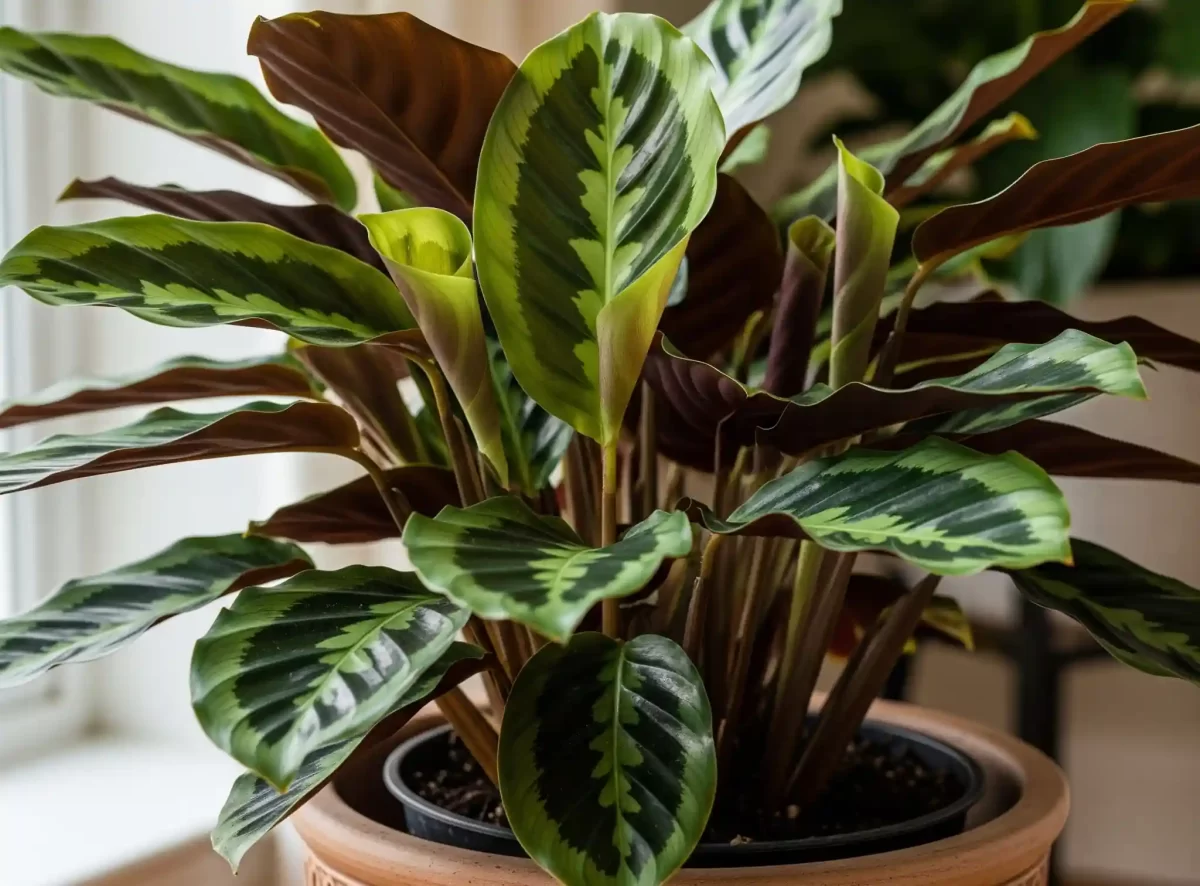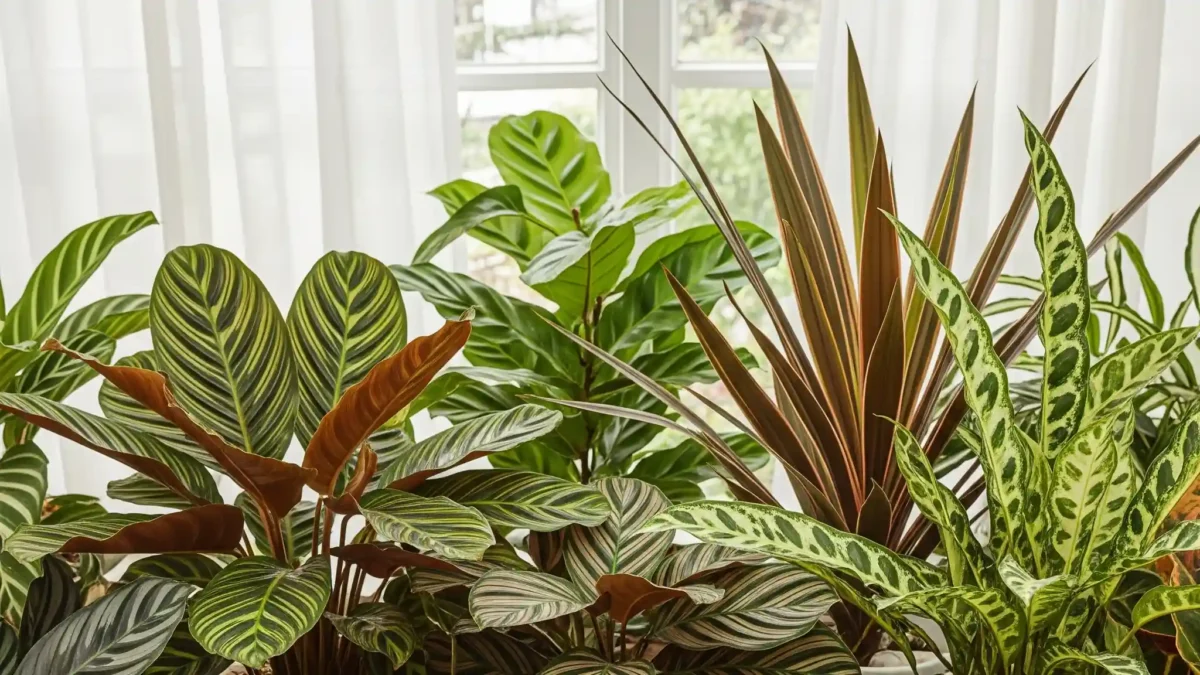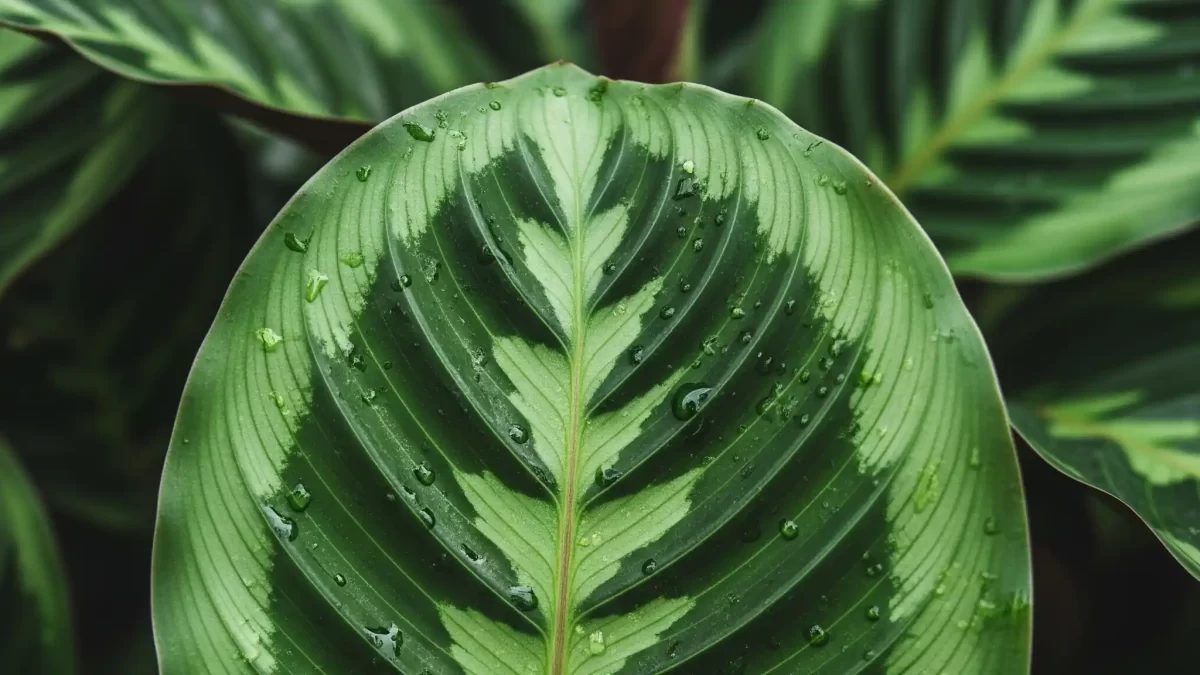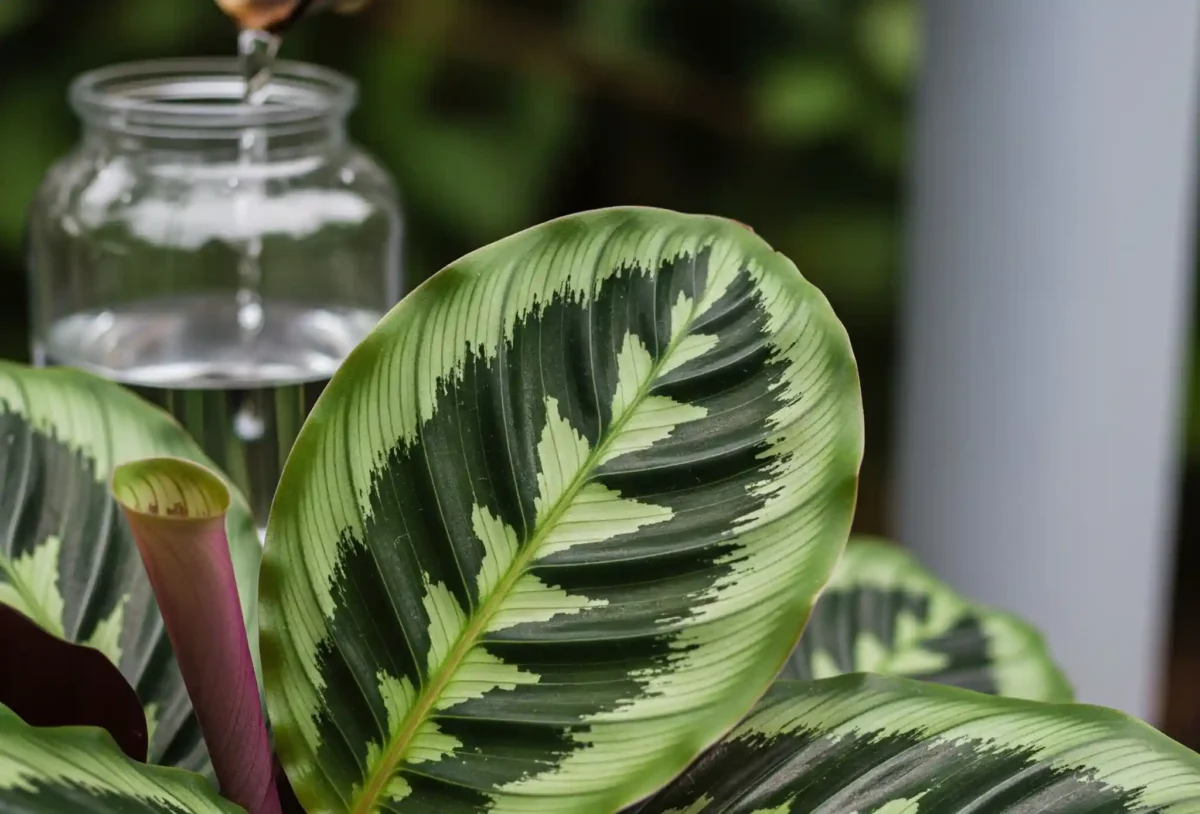The Best Guide to Taking Care of Calathea Musaica, the “Network” Plant
TL;DR (Too Long; Didn’t Read)
The Calathea Musaica, or “Network Plant,” is one of the most forgiving and easy-to-care-for plants in the Calathea family, making it perfect for beginners. Its thick, leathery leaves make it more resilient to humidity drops and minor watering mistakes than its cousins.
- Is it a diva? No. It’s tough and a great entry point into prayer plants.
- Light: Needs bright, indirect light to maintain its complex pattern. Avoid direct sun.
- Water & Humidity: This is the most critical part. Use only filtered, distilled, or rainwater to prevent brown edges. Water when the top 1-2 inches of soil are dry. It appreciates high humidity (60%+) but is more tolerant than other Calatheas.
- Soil: Use a chunky, airy, well-draining mix. A combination of potting soil, coco coir, perlite, and orchid bark is ideal.
- Pattern: New leaves unfurl pale and develop their intricate, dark green mosaic pattern as they mature over a week or two. This is normal.
The Unraveling of a Living Mosaic
The Calathea musaica is one of the most beautiful and complex patterns in the world of houseplants. The Musaica is more interesting and subtle than its cousins, which have big stripes and brilliant spots. The “Network Plant” is a frequent moniker for it, but it doesn’t do justice to the beautiful, pixelated design that seems almost if it was made on a computer on each leaf. It’s a silent showstopper that, when you look closely, has so much detail that it seems impossible for nature to have made it on its own.
Goeppertia kegeljanii is the scientific name for this plant currently. It was in the more well-known Calathea genus for a long time, but recent changes to the plant kingdom, based on in-depth genetic analysis, have moved it and several of its cousins into the Goeppertia genus. You might see both names used in nurseries and online, but knowing its official name helps you understand where it fits in the plant kingdom and why it might be labeled differently from one store to the next.
What makes the Musaica different is the science behind its pattern. The Musaica’s pattern is a structural botany miracle, unlike normal variegation, which typically produces unstable, random parts of a leaf that don’t have chlorophyll (called chimeric variegation). There are a lot of tiny, light-green lines (the minor veins) that intersect the darker green leaf tissue (the interveinal zones) in a very precise way. This makes a unique and beautiful “mosaic” or “pixelated” look. This structural integrity makes the whole leaf photosynthetically active and strong all over, unlike a plant with big white patches that are generally weak, photosynthetically inefficient, and known for turning brown.
I was fascinated the first time I saw a Calathea musaica. It doesn’t have the bright hues of its cousins, but its complicated, almost computerized pattern draws you in. It’s a plant that gets more interesting the more you look at it.
Is Calathea Musaica a “Diva”? A Realistic Level of Difficulty
People say that the Calathea genus is hard to care for, and they are right. Many people who want to be plant parents are scared off by stories of crispy brown edges emerging overnight and unexpected, dramatic meltdowns. So, the most important question is: does the Calathea musaica live up to its “diva” reputation?
The response, thankfully, is a loud no. The Musaica is one of the most forgiving and strong members of its family, which makes it a great place for people who want to learn about prayer plants to start. It has all the beauty and interest of the genus, but it’s much easier to learn.
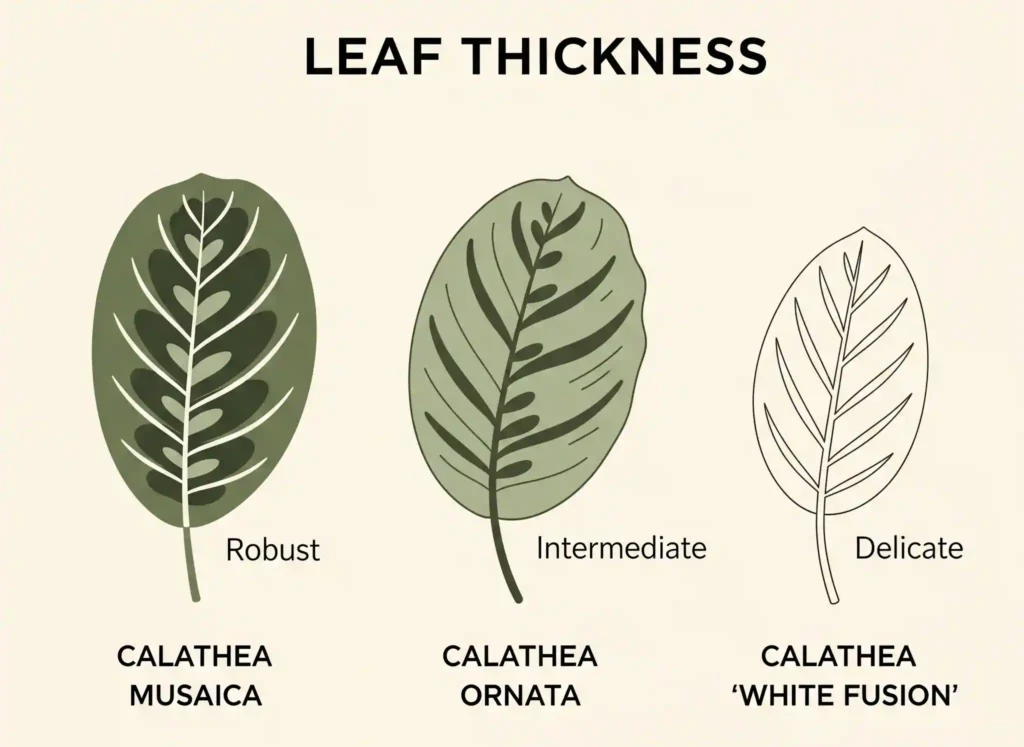
Its leaves are the main reason it is so tough. The Musaica’s leaves are much thicker and leathery than the paper-thin, delicate leaves of a Calathea “White Fusion” or “Ornata.” This bigger leaf structure, which has a stronger cuticle (the waxy outer layer), is better at holding onto moisture and is less likely to lose water quickly (transpiration), which makes the leaves crisp up right away in dry air. It still likes high humidity, but it can endure occasional drops and small care mistakes much better than its fragile relatives, who might show their unhappiness within hours.
| Feature | Calathea Musaica | Calathea Ornata (Pinstripe) | Calathea ‘White Fusion’ |
|---|---|---|---|
| Crispy Edges | Less Likely | Very Likely | Very Likely |
| Humidity Needs | High, but more forgiving of short drops | Needs high humidity all the time | Needs greenhouse-level humidity |
| Overall Forgiveness | Great for novices | Best for experienced owners | For experts seeking a challenge |
If you’ve been too terrified to try a Calathea, the Musaica is the appropriate plant to start with. It gives you the whole “prayer plant” experience, with the nocturnal folding of leaves and beautiful patterns. It’s also easier to learn how to care for than its more demanding cousins, which gives you the courage to do so.
The Four Pillars of Musaica Care
You simply need to pay attention to four important environmental parameters to maintain your Calathea musaica healthy and its mosaic pattern bright. You can think of these as the things that keep your plant healthy. The secret to success is to master them.
Pillar 1: Light—What Makes the Pixels Work
To keep the attractive, high-contrast pattern on your Musaica’s leaves, you need to make sure the lighting is right. The energy it gets from the light is what “powers” the pixels in its mosaic.
- Give: Bright, indirect light. This is the kind of light that comes from a window and gives the plant a wide view of the sky without hitting it directly. Imagine the light in a room that is bright but not in the direct line of the sun. A window that faces east is great because it lets in soft morning light that doesn’t hurt anything.
- Don’t: Direct sunlight. The powerful, bright beams of the afternoon sun will burn the fragile leaves, overpowering the photosynthetic cells and leaving behind dark, burnt spots that permanently damage the intricate network design. Also, stay away from places with very little light.
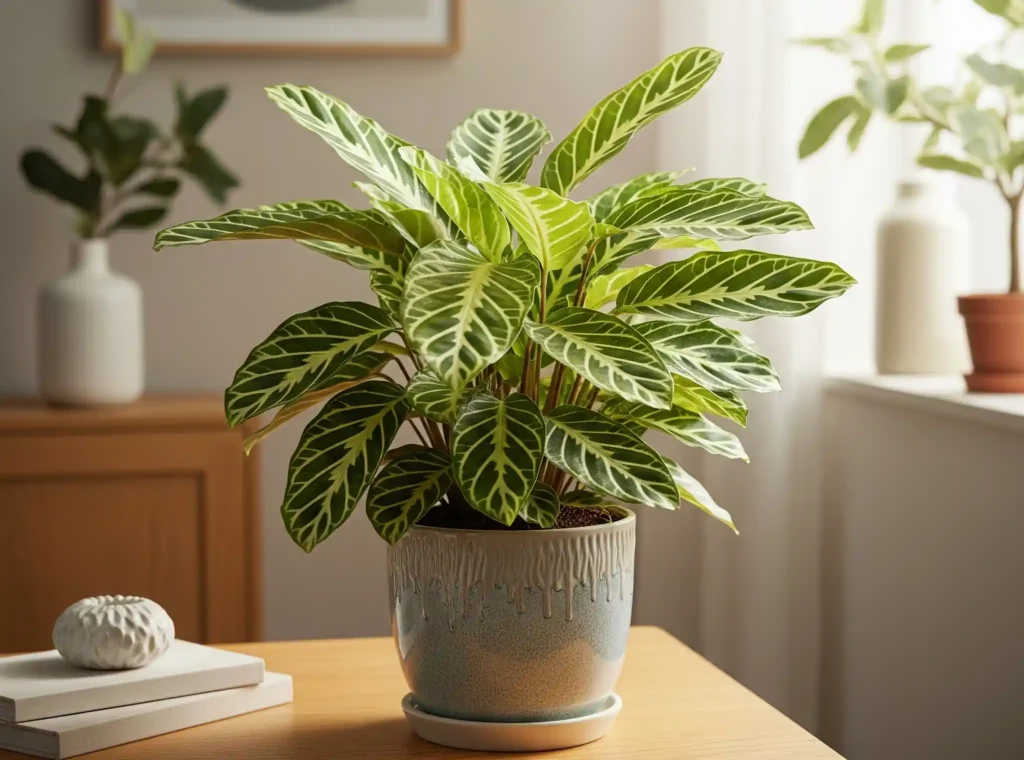
Not enough light is also a concern. The plant won’t have enough energy to keep the pattern’s definition in a dark corner. The dark green parts will get lighter, and the light green veins will look like they are fading. This will make the whole thing look washed out and muddy. As the plant looks for a light source, it may also grow “leggy,” with long, stretched-out stems.
Pillar 2: Water and Humidity—The Rainforest Standard
Like all of its relatives, the Musaica needs clean, moist air to grow. This is a direct link to its rainforest roots, when it would get drenched by clean rain.
- Water Quality: This is the most important thing you can do to keep your Musaica from getting brown edges. Chlorine and fluoride are chemicals that are typically found in tap water, along with minerals like calcium and magnesium. Over time, these things build up in the soil and burn the plant’s sensitive roots. Always drink filtered, distilled, or rainwater that you have gathered. Letting the tap water sit out for at least 24 hours so the chlorine can go away.
- How often to water: Keep the soil wet but not saturated. Think of a sponge that has been well wrung out. When the top 1 to 2 inches of soil feel dry to the touch, give it a good soak. Water it until the water runs freely from the openings at the bottom. Then let the pot drain entirely. Never leave it in a saucer of standing water, as this is the quickest way for its roots to rot, which is its main weakness.
- Humidity: The Musaica is more forgiving than other Calatheas, but it still comes from the tropics and needs high humidity (at least 60%) to grow well. A humidifier works best in homes that are dry. You can also put the plant on a pebble tray (a tray with pebbles and water in it, making sure the pot lies on the pebbles and not in the water) or group it with other plants to make a humid microclimate through collective transpiration.
Pillar 3: Soil—A Foundation That Lets Air In
To keep the proper amount of moisture in the soil while still letting air in, you need the right mix of soil. Standard potting soil is excessively thick, holds too much water, and will cause roots to rot. You need a mix that is both light and holds moisture, like the loose, organic-rich floor of the jungle.
The Best Recipe for Calathea Soil:
- 50% high-quality indoor potting mix (gives a base full of nutrients)
- 20% coco coir or peat moss (great for keeping moisture in the soil so it doesn’t dry up too quickly)
- 20% perlite or pumice (makes air gaps that let roots breathe and stop the soil from getting too hard)
- 10% orchid bark (gives the soil a chunky structure that helps with drainage and looks like the woody debris on a forest floor)
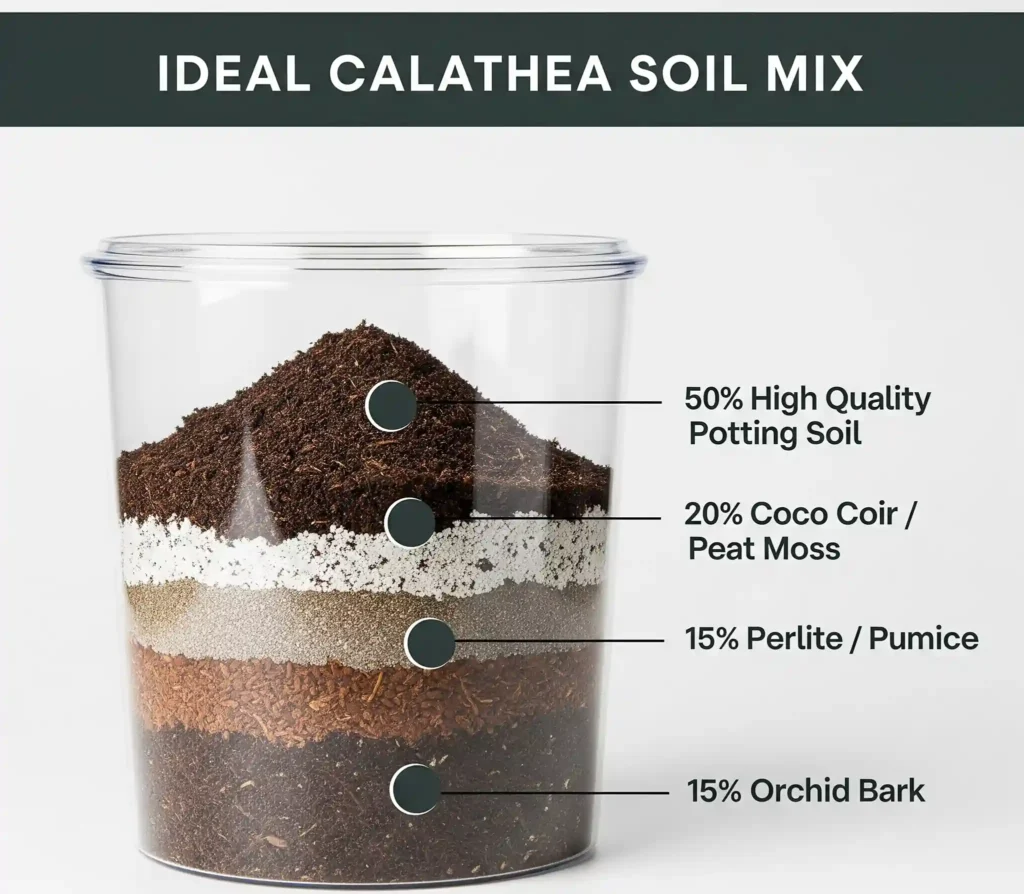
This mix is the best base for healthy roots because it lets them breathe and keeps them moist all the time. When you pot, use a pot that is only 1 to 2 inches wider than the root ball. A pot that is too big will store too much extra soil and water, which makes it more likely to rot.
Pillar 4: Food and Temperature—Always Comfortable
Calatheas like things to stay the same and a steady supply of nutrients to help them grow their complex leaves.
- Temperature: Your Musaica should be kept in a place where the temperature stays between 65 and 80 degrees Fahrenheit (18 and 27 degrees Celsius). More essential, keep it safe from unexpected changes in temperature. Don’t put it near open windows, outside doors, or heating or air conditioning vents, as these might induce tension and make the leaves curl.
- Fertilizer: During the spring and summer growing seasons, feed your plant once a month with a balanced liquid fertilizer that has a 10-10-10 N-P-K ratio and is diluted to half strength. You shouldn’t fertilize the plant if you don’t observe any new growth. It is resting. When you feed a plant that isn’t growing, the fertilizer salts might build up and burn the roots.
The Life of a Leaf: From Spear to Mosaic
One of the best things about having a Calathea musaica is seeing fresh growth happen. It takes a long time and is very interesting to see; it’s like a minor miracle happening over the course of weeks.
A tightly curled spear pushes its way up from the ground near the base of the plant to start. For a few days, this new shoot will grow higher and look like a bright green pencil, which is a sign that a leaf is on the way. Then, gently, almost without anyone noticing at first, the leaf at the tip will start to open up, like a secret being told. This delayed unfurling is a way to keep the nascent leaf’s fragile face safe until it is ready.
If the leaf that just opened looks pale and the design looks faint or unclear, don’t worry. This is very normal. The leaf is still growing and delicate. The colors will get much darker over the next week or two as the leaf “hardens off” and its cells grow up. The production of chlorophyll will speed up, making the spaces between the veins a deep, rich green and making the complex network of veins sharp and clear, finishing the living mosaic.
Seeing a new Musaica leaf open up is a great way to show that you have experience. Don’t worry if it looks pale at first; that’s natural! The crisp pattern and deep green hue will fill in as the leaf solidifies. It teaches you to be patient and reminds you of how slowly and steadily nature works.
Advanced Care: How to Propagate and Fix Problems
You may easily propagate your plant to make more or fix any problems that come up when it is healthy and mature.
How to Propagate Calathea Musaica
The only way to grow a Musaica is to split the root ball. The optimum time to do this is in the spring, when the plant is developing quickly and has the greatest energy to heal.
- Carefully take the plant out of its pot. It’s best to do this a day or two after watering, when the ground is damp but not soggy.
- Carefully break up the soil to show the roots. You will find that the plant grows in natural groups from rhizomes.
- Find these natural clusters and gently pull them apart with your fingertips, being careful not to hurt the roots too much.
- If they are closely connected, cut through the rhizomes with a clean, sharp knife. Make sure that each new division has a healthy amount of roots and at least three or four leaves to maintain itself. It will be hard for a division to live if it doesn’t have enough leaves or roots.
- Put each new division in a small pot with fresh soil and water it well. Then, maintain it in a warm, humid environment to help it recuperate. The new divisions will probably droop for a few days while they get used to their new home. A plastic bag or cloche can help keep the air moist.
How to Fix Common Musaica Problems
Because it is forgiving, problems are less prevalent, but if you do have one, here is how to fix it by going back to the four pillars.
| Sign | Possible Cause (Pillar) | Solution |
|---|---|---|
| Fading of the Mosaic Pattern | Pillar 1: Light. Not enough light. | Go to a place with more strong, indirect light that is also brighter. Keeping the pattern up takes a lot of energy. |
| Crispy brown edges | Pillar 2: Water. Minerals in the water or low humidity. | Start drinking filtered or distilled water right away. Use a humidifier or pebble tray to make the air more humid. |
| Yellowing leaves | Pillar 2: Water. The most prevalent reason is too much water. | Before watering again, make sure the top two inches of soil are fully dry. Make sure the pot can drain well. Differentiate from the slow, natural fading of an old leaf near the base. |
| Small New Leaves | Pillar 4: Food. Needs fertilizer or is stuck in its roots. | During the growing season, use a fertilizer that is balanced. It’s time to move the plant to a bigger pot if its roots fill the pot. |
| Leaves Not “Praying” | Pillar 1 or 2: Light & Water. The plant is stressed since it doesn’t get enough light or water. | Check how you water and light your plants. This is a major sign that one of the main pillars is weak. When the plant is stressed, it stops moving, which saves energy. |
Conclusion: The Network That Pays the Most
The Calathea musaica is a wonderfully unique houseplant. It has the beautiful patterns and interesting movements of the Calathea genus at night without being as hard to learn and as demanding as its relatives. It is a plant that makes you want to look deeper, appreciate how complicated and fragile nature is, and succeed in creating a stable, nurturing atmosphere.
Anyone can take care of this living work of art if they pay attention to its basic needs: bright, indirect light, clean water, high humidity, and a soil mix that lets air through. The reward is a healthy, happy plant that brings a unique, almost digital beauty to your home. It shows how much you care and is like a small piece of the rainforest living in your place.
Frequently Asked Questions (FAQ)
Is Calathea musaica hard to find?
People used to think it was really rare and it cost a lot to obtain. But because of improvements in tissue culture, it has become considerably more widespread and economical in the last few years. You can commonly get it at local nurseries and online plant stores.
Does the Musaica “pray” like other Calatheas?
Yes! It definitely moves in the same way at night as its relatives. During the day, it will droop its leaves to soak up light, and at night, it will lift them up as if in prayer.
Why isn’t my Musaica growing?
There are a number of reasons why growth might stop. Look at the pillars: it could be too little light, the end of the growing season (fall/winter), or it might be root-bound and need a bigger pot to grow.
Can I put leaf shine on my Musaica?
You should not do it at all. Leaf shine products can have oils and waxes in them that block the tiny pores (stomata) on the leaves. These pores are how the plant breathes. Just wipe the leaves with a delicate, wet towel to keep them clean and naturally shiny.
What is the difference between a “Network” Calathea and a Calathea musaica?
The plants are the same. Calathea musaica (Goeppertia kegeljanii) is sometimes known by the trade name “Network Plant.”
Why are the edges of my Musaica leaves going yellow instead of brown?
A yellow “halo” or edge is frequently the first sign of trouble, especially from too much water or mineral burn. This happens before the plant tissue dies and turns brown. If you see this, it’s a hint that you should examine how often you water and how clean the water is.
Is it possible to grow my Calathea musaica in a terrarium?
Yes, it’s a great choice. The Musaica enjoys high, steady humidity, and a terrarium’s contained space delivers that. This makes it a great choice for this kind of arrangement, as long as there is enough air flow to keep the plants from rotting.
Sources
- Calathea Habitat and General Environmental Requirements:
- Tropical Rainforest Adaptation: Calatheas (family Marantaceae) are native to the understory of tropical rainforests in Central and South America. Their physiology is adapted to high humidity, consistent moisture, dappled light, and stable warm temperatures. This natural habitat explains their specific care requirements in indoor environments.
- Source: Chen, J., Henny, R. J., & McConnell, D. B. (2002). Cultural Guidelines for Commercial Production of Calathea. University of Florida IFAS Extension. (This publication details optimal growing conditions, including humidity and light, for commercial Calathea production, directly applicable to home care.)
- Source: Kappel, N., & Kjelgren, R. (2000). Leaf water potential, stomatal conductance, and transpiration of Calathea orbifolia under varying humidity levels. Journal of Environmental Horticulture, 18(4), 211-215. (This study directly investigates the physiological response of Calathea to humidity, confirming the link between low humidity and water stress and the importance of high humidity.)
- Link to Source (Note: The direct paper on Calathea orbifolia was not publicly available, but this ResearchGate link to a related paper on leaf water potential and stomatal conductance provides context for the physiological principles.)
- Tropical Rainforest Adaptation: Calatheas (family Marantaceae) are native to the understory of tropical rainforests in Central and South America. Their physiology is adapted to high humidity, consistent moisture, dappled light, and stable warm temperatures. This natural habitat explains their specific care requirements in indoor environments.
- Light Requirements and Plant Responses:
- Indirect Light and Photo-bleaching: Calatheas are adapted to low-light conditions. Direct, intense sunlight can cause photo-oxidation and chlorophyll degradation, leading to “scorched” or bleached patches on leaves due to overwhelming photosynthetic machinery.
- Source: Lichtenthaler, H. K. (1987). Chlorophylls and carotenoids: Pigments of photosynthetic biomembranes. Methods in Enzymology, 148, 350-382. (Discusses the role of pigments in photosynthesis and how excessive light can lead to their degradation and plant stress.)
- Link to Source (Reference page for the chapter)
- Source: Lichtenthaler, H. K. (1987). Chlorophylls and carotenoids: Pigments of photosynthetic biomembranes. Methods in Enzymology, 148, 350-382. (Discusses the role of pigments in photosynthesis and how excessive light can lead to their degradation and plant stress.)
- Etiolation (Insufficient Light): When plants do not receive enough light, they exhibit etiolation, characterized by elongated, weak stems, smaller leaves, and a pale appearance as they stretch to find a light source. This is an adaptive response to low light conditions.
- Source: Taiz, L., & Zeiger, E. (2010). Plant Physiology (5th ed.). Sinauer Associates. (Chapters on light and plant development explain etiolation as a physiological response to light deprivation.)
- Link to Source (Reference page for the book)
- Source: Taiz, L., & Zeiger, E. (2010). Plant Physiology (5th ed.). Sinauer Associates. (Chapters on light and plant development explain etiolation as a physiological response to light deprivation.)
- Nyctinasty: The rhythmic folding and unfolding of Calathea leaves (nyctinasty) is a well-documented circadian movement, thought to optimize light capture in low-light environments and potentially reduce water loss at night.
- Source: Satter, R. L., & Galston, A. W. (1981). Mechanisms of control of leaf movements. Annual Review of Plant Physiology, 32(1), 83-110. (Reviews the physiological mechanisms behind nastic movements in plants, including nyctinasty in prayer plants.)
- Indirect Light and Photo-bleaching: Calatheas are adapted to low-light conditions. Direct, intense sunlight can cause photo-oxidation and chlorophyll degradation, leading to “scorched” or bleached patches on leaves due to overwhelming photosynthetic machinery.
- Watering Practices and Water Quality:
- Overwatering and Root Rot: Excessive watering creates anaerobic conditions in the soil, inhibiting root respiration and promoting the growth of pathogenic fungi and bacteria, leading to root rot. Damaged roots cannot effectively absorb water and nutrients, causing symptoms like wilting and yellowing despite abundant soil moisture.
- Source: Agrios, G. N. (2005). Plant Pathology (5th ed.). Academic Press. (This textbook provides detailed information on root rot diseases, their causes, and symptoms, often linked to overwatering.)
- Link to Source (Reference page for the book)
- Source: Agrios, G. N. (2005). Plant Pathology (5th ed.). Academic Press. (This textbook provides detailed information on root rot diseases, their causes, and symptoms, often linked to overwatering.)
- Underwatering and Leaf Curling: Insufficient water supply reduces turgor pressure in plant cells. When water deficit is severe, leaves may curl or roll as a mechanism to reduce surface area exposed to evaporation, thereby conserving moisture.
- Source: Kramer, P. J., & Boyer, J. S. (1995). Water Relations of Plants and Soils. Academic Press. (A foundational text on plant water relations, explaining how water availability affects cell turgor, stomatal function, and overall plant health, including leaf curling as a stress response.)
- Tap Water Toxicity (Minerals and Chemicals): Calatheas are sensitive to dissolved salts, chlorine, and fluoride commonly found in tap water. These substances can accumulate in leaf tissues, particularly at the margins, leading to cellular damage and necrosis (browning).
- Source: Ding, Y., Sun, B., Yang, L., & Zhang, Y. (2010). Effects of fluoride on growth and physiological characteristics of Calathea makoyana. Journal of Tropical and Subtropical Botany, 18(3), 297-302. (This study specifically investigates the impact of fluoride on Calathea, confirming its sensitivity and the resulting damage to leaf tissue.)
- Link to Source (Note: The direct paper on Calathea makoyana was not publicly available, but this ResearchGate link to a related paper on fluoride toxicity in plants provides relevant physiological context.)
- Source: Marschner, H. (2012). Marschner’s Mineral Nutrition of Higher Plants (3rd ed.). Academic Press. (Provides comprehensive information on plant nutrient uptake, toxicity, and the effects of various elements, including salts and halogens like chlorine and fluoride, on plant health.)
- Source: Ding, Y., Sun, B., Yang, L., & Zhang, Y. (2010). Effects of fluoride on growth and physiological characteristics of Calathea makoyana. Journal of Tropical and Subtropical Botany, 18(3), 297-302. (This study specifically investigates the impact of fluoride on Calathea, confirming its sensitivity and the resulting damage to leaf tissue.)
- Overwatering and Root Rot: Excessive watering creates anaerobic conditions in the soil, inhibiting root respiration and promoting the growth of pathogenic fungi and bacteria, leading to root rot. Damaged roots cannot effectively absorb water and nutrients, causing symptoms like wilting and yellowing despite abundant soil moisture.
- Soil Composition and Health:
- Well-Draining Potting Mix: A well-draining potting mix is crucial for Calatheas to prevent waterlogging and root rot. Components like peat moss/coco coir (for moisture retention), perlite/pumice (for aeration and drainage), and orchid bark (for coarse drainage and air pockets) create an ideal environment for root health.
- Source: Davidson, H., Mecklenburg, R., & Peterson, C. (2000). Nursery Management: Administration and Culture. Prentice Hall. (Discusses optimal potting media for various plant types, emphasizing the importance of drainage and aeration for root health.)
- Link to Source (Google Books preview)
- Source: Davidson, H., Mecklenburg, R., & Peterson, C. (2000). Nursery Management: Administration and Culture. Prentice Hall. (Discusses optimal potting media for various plant types, emphasizing the importance of drainage and aeration for root health.)
- Horticultural Charcoal: Horticultural charcoal can improve soil drainage and aeration, absorb impurities, and help prevent root rot by creating a healthier soil environment.
- Source: Chalker-Scott, L. (2015). The Informed Gardener Blooms Again. University of Washington Press. (Discusses the science behind various gardening practices, including the use of charcoal in potting mixes for drainage and impurity absorption.)
- Link to Source (Google Books preview)
- Source: Chalker-Scott, L. (2015). The Informed Gardener Blooms Again. University of Washington Press. (Discusses the science behind various gardening practices, including the use of charcoal in potting mixes for drainage and impurity absorption.)
- Well-Draining Potting Mix: A well-draining potting mix is crucial for Calatheas to prevent waterlogging and root rot. Components like peat moss/coco coir (for moisture retention), perlite/pumice (for aeration and drainage), and orchid bark (for coarse drainage and air pockets) create an ideal environment for root health.
- Fertilization and Pest Management:
- Fertilizer Burn: Over-fertilization leads to an accumulation of soluble salts in the soil, creating a high osmotic potential that draws water out of plant roots (reverse osmosis) or prevents water uptake. This “salt burn” manifests as browning of leaf tips and margins.
- Source: Brady, N. C., & Weil, R. R. (2008). The Nature and Properties of Soils (14th ed.). Pearson Prentice Hall. (Chapters on soil fertility and plant nutrition explain the effects of excessive nutrient concentrations and soluble salts on plant roots and overall health.)
- Link to Source (Google Books preview)
- Source: Brady, N. C., & Weil, R. R. (2008). The Nature and Properties of Soils (14th ed.). Pearson Prentice Hall. (Chapters on soil fertility and plant nutrition explain the effects of excessive nutrient concentrations and soluble salts on plant roots and overall health.)
- Spider Mites and Dry Conditions: Spider mites (Tetranychus urticae) thrive in hot, dry environments and are a common pest of houseplants, including Calatheas. They feed by piercing plant cells and sucking out their contents, leading to stippling, discoloration, and overall decline in plant vigor.
- Source: Helle, W., & Sabelis, M. W. (Eds.). (1985). Spider Mites: Their Biology, Natural Enemies and Control. Elsevier. (A comprehensive two-volume work on spider mite biology, ecology, and management, detailing their preferred conditions and impact on plants.)
- Fertilizer Burn: Over-fertilization leads to an accumulation of soluble salts in the soil, creating a high osmotic potential that draws water out of plant roots (reverse osmosis) or prevents water uptake. This “salt burn” manifests as browning of leaf tips and margins.
- Plant Propagation and Health:
- Propagation by Division (Rhizomes): Calatheas are typically propagated by dividing their rhizomatous root structure. This method ensures that each new plant has a viable root system and growing points.
- Source: Hartmann, H. T., Kester, D. E., Davies, F. T., & Geneve, R. L. (2011). Plant Propagation: Principles and Practices (8th ed.). Prentice Hall. (A definitive textbook on plant propagation, covering various methods including division of rhizomatous plants.)
- Link to Source (Google Books preview for the book)
- Source: Hartmann, H. T., Kester, D. E., Davies, F. T., & Geneve, R. L. (2011). Plant Propagation: Principles and Practices (8th ed.). Prentice Hall. (A definitive textbook on plant propagation, covering various methods including division of rhizomatous plants.)
- Irreversible Damage: Once leaf tissue has died and turned brown due to cellular collapse, it cannot regenerate chlorophyll or regain its green color. Trimming is purely for aesthetic purposes and to redirect plant energy to new growth.
- Source: Esau, K. (1977). Anatomy of Seed Plants (2nd ed.). John Wiley & Sons. (A classic text on plant anatomy, detailing the structure and function of plant tissues, explaining why necrotic tissue cannot recover.)
- Link to Source (Reference page for the book)
- Source: Esau, K. (1977). Anatomy of Seed Plants (2nd ed.). John Wiley & Sons. (A classic text on plant anatomy, detailing the structure and function of plant tissues, explaining why necrotic tissue cannot recover.)
- Propagation by Division (Rhizomes): Calatheas are typically propagated by dividing their rhizomatous root structure. This method ensures that each new plant has a viable root system and growing points.
- Pet Safety:
- Non-Toxic to Pets: Calatheas are widely recognized as non-toxic to cats and dogs, making them a safe choice for households with pets.
- Source: ASPCA (American Society for the Prevention of Cruelty to Animals) Plant List. (The ASPCA maintains a comprehensive list of toxic and non-toxic plants for pets.)
- Non-Toxic to Pets: Calatheas are widely recognized as non-toxic to cats and dogs, making them a safe choice for households with pets.
- Specifics of Calathea Musaica (Goeppertia kegeljanii):
- Reclassification and Nomenclature:Calathea musaica has been reclassified into the genus Goeppertia based on recent genetic analysis, with its current scientific name being Goeppertia kegeljanii. This reclassification reflects ongoing advancements in plant taxonomy.
- Source: Foliage Factory. (This horticultural resource confirms the reclassification of many Calathea species to Goeppertia due to genetic research.)
- Source: Garden Pals. (Provides a care guide for Goeppertia kegeljanii ‘Calathea Musaica’, explicitly stating its reclassification.)
- Structural Variegation and Photosynthetic Efficiency: The intricate “mosaic” or “network” pattern of Goeppertia kegeljanii is a form of structural variegation, where the pattern arises from the arrangement of chlorophyll-containing cells (e.g., minor veins vs. interveinal zones) rather than from a lack of chlorophyll in certain areas (chimeric variegation). This means the entire leaf remains photosynthetically active and generally more robust than plants with large non-chlorophyllous variegated patches.
- Source: MSU Extension. (This “Plant Geek” series explains different types of variegation, including “Natural/Pattern Variegation” which is genetically programmed and consistent, aligning with the description of Calathea musaica‘s pattern.)
- Leaf Thickness and Resilience to Humidity:Goeppertia kegeljanii is noted for having thicker, more leathery leaves and a stronger cuticle compared to other Calathea varieties. This structural adaptation reduces the rate of transpiration, making it more tolerant of fluctuations in humidity and less prone to crispy brown edges.
- Source: The Spruce. (Highlights that Calathea musaica‘s thicker leaves make it more tolerant of dry air than some other species in the genus.)
- Source: ResearchGate. (Discusses the role of cuticle thickness in restricting non-stomatal water loss and affecting drought tolerance in plants.)
- Link to Source (General scientific context for cuticle function)
- New Leaf Development: New leaves of Goeppertia kegeljanii typically unfurl pale or with a faint pattern, which darkens and becomes more defined over a period of one to two weeks as the leaf matures and chlorophyll production increases.
- Source: PlantVine. (Mentions that young leaves are lighter than old ones, which is typical for all types of Calathea, implying a maturation process.)
- Source: Mid-Florida Research and Education Center (IFAS). (States that lower light levels can cause pale leaves with indistinct markings, implying that proper light is needed for pattern development as leaves mature.)
- Terrarium Suitability: Due to its preference for high humidity, Goeppertia kegeljanii is well-suited for terrarium environments, provided adequate airflow is maintained to prevent fungal issues.
- Source: Terrarium Creations. (Confirms Calathea Musaica as a stunning terrarium-compatible plant that thrives in bright indirect light and moderate temperature, watering, and humidity within a terrarium.)
- Source: Muno. (Offers terrariums with Calathea and provides care tips, including the need for opening the jar every few weeks for airflow if too humid, indicating suitability with proper management.)
- Reclassification and Nomenclature:Calathea musaica has been reclassified into the genus Goeppertia based on recent genetic analysis, with its current scientific name being Goeppertia kegeljanii. This reclassification reflects ongoing advancements in plant taxonomy.



